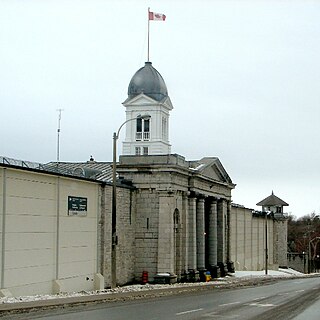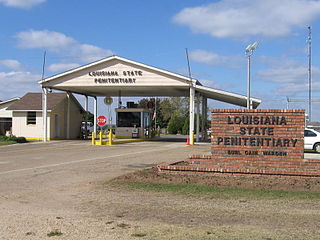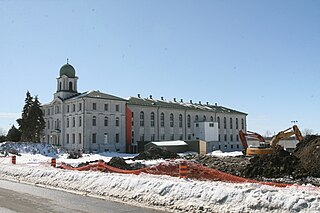
Kingston Penitentiary is a former maximum security prison located in Kingston, Ontario, Canada, between King Street West and Lake Ontario.

The Minnesota Correction Facility – Stillwater (MCF-STW) is a close custody state prison for men in Bayport, Minnesota, United States. Built 1910–1914, it houses 1,600 inmates in seven different living areas. Additionally, approximately 100 inmates are housed in a nearby minimum security area. It replaced the original Minnesota Territorial Prison located just to the north in the city of Stillwater, Minnesota. Until recent expansion of the medium custody Minnesota Correctional Facility – Faribault, MCF-STW was the state's largest facility by inmate population. A historic district consisting of 22 contributing properties was listed on the National Register of Historic Places in 1986 as the State Prison Historic District for having state-level significance in architecture. It was nominated for being one of the nation's earliest and most influential appearances of the "telephone pole" layout, with a large main hallway connecting each of the units, that was widely adopted by high-security prisons. MCF-STW is noted for its award-winning publication The Prison Mirror, the oldest continuously-operated prison newspaper in the United States.

The Louisiana State Penitentiary is a maximum-security prison farm in Louisiana operated by the Louisiana Department of Public Safety & Corrections. It is named "Angola" after the former slave plantation that occupied this territory. The plantation was named after the country of Angola from which many slaves originated before arriving in Louisiana.

The Don Jail was a jail in Toronto, Ontario, Canada, located to the east of the Don River, on Gerrard Street East in the Riverdale neighbourhood. The original building was completed in 1864 and was reopened in 2013 to serve as the administrative wing of Bridgepoint Active Healthcare, a rehabilitation hospital located adjacent to the jail. Prior to its adaptive reuse as part of a healthcare facility, the building was used as a provincial jail for remanded offenders and was officially known as the Toronto Jail. The jail originally had a capacity of 184 inmates, and it was separated into an east wing for the men and a west wing for the women.

The Dominion Public Building is a five-storey Beaux-Arts neoclassical office building built between 1926 and 1935 for the government of Canada at southeast corner of Front and Bay streets in Toronto, Ontario, Canada.

Tennessee State Prison is a former correctional facility located six miles west of downtown Nashville, Tennessee on Cockrill Bend. It opened in 1898 and has been closed since 1992 because of overcrowding concerns. The mothballed facility was severely damaged by an EF3 tornado in the tornado outbreak of March 2–3, 2020.

Islington-City Centre West is a commercial and residential neighbourhood in Etobicoke, Toronto, Ontario, Canada. One of four central business districts outside Downtown Toronto, it is bounded by Rathburn Road to the north, Islington Avenue to the east, Bloor Street to the south, Mimico Creek to the west.
Great Meadow Correctional Facility is a maximum security prison in New York State in the United States. The prison is in Comstock, a hamlet right outside of Fort Ann, in Washington County, New York. As of September 3, 2008 it was home to 1,663 inmates. When Great Meadow opened in 1911 it was the fourth prison for adult males constructed in the state of New York.
The Oklahoma State Reformatory is a medium-security facility with some maximum and minimum-security housing for adult male inmates. Located off of State Highway 9 in Granite, Oklahoma, the 10-acre (4.0 ha) facility has a maximum capacity of 1042 inmates. The medium-security area accommodates 799 prisoners, minimum-security area houses roughly 200, and the maximum-security area with about 43 inmates. The prison currently houses approximately 975 prisoners. The prison was established by an act of the legislature in 1909 and constructed through prison labor, housing its first inmate in 1910. The facility is well known for the significant roles women played in its foundation and governance, most notably having the first female warden administer an all-male prison in the nation.

Lansing Correctional Facility (LCF) is a state prison operated by the Kansas Department of Corrections. LCF is located in Lansing, Kansas, in Leavenworth County. LCF, along with the Federal Bureau of Prison's United States Penitentiary, Leavenworth, the United States Army Corrections Command's United States Disciplinary Barracks, and Midwest Joint Regional Correctional Facility in Fort Leavenworth are the four major prisons that give the Leavenworth area its reputation as a corrections center.
The Toronto South Detention Centre is a correctional facility in the district of Etobicoke in Toronto, Ontario, Canada. It is a Government of Ontario-operated maximum-security correctional facility for adult male inmates serving a sentence of up to 2-years-less-a-day, and offenders who have been remanded into custody while awaiting trial. It is built on the site of the former Mimico Correctional Centre, which closed in 2011 and whose origins dated back to 1887. The Toronto South Detention Centre officially opened on January 29, 2014 replacing the Toronto Jail, the Toronto West Detention Centre, and the demolished Mimico Correctional Centre.

The Ohio Penitentiary, also known as the Ohio State Penitentiary, was a prison operated from 1834 to 1984 in downtown Columbus, Ohio, in what is now known as the Arena District. The state had built a small prison in Columbus in 1813, but as the state's population grew the earlier facility was not able to handle the number of prisoners sent to it by the courts. When the penitentiary first opened in 1834, not all of the buildings were completed. The prison housed 5,235 prisoners at its peak in 1955. Prison conditions were described as "primitive" and the facility was eventually replaced by the Southern Ohio Correctional Facility, a maximum security facility in Lucasville. During its operation, it housed several well-known inmates, including General John H. Morgan, who famously escaped the prison during the Civil War, "Bugs" Moran, O. Henry, Chester Himes, and Sam Sheppard, whose story is said to have inspired the movie The Fugitive. A separate women's prison was built within its walls in 1837. The buildings were demolished in 1997.

The Nevada Department of Corrections (NDOC) is a governmental agency in the U.S. state of Nevada. The NDOC headquarters is located on the property of the Stewart Indian School in Carson City.

Michigan State Prison or Jackson State Prison, which opened in 1839, was the first prison in Michigan. After 150 years, the prison was divided, starting in 1988, into four distinct prisons, still in Jackson: the Parnall Correctional Facility which is a minimum-security prison; the G. Robert Cotton Correctional Facility where prisoners can finish their general education; the Charles Egeler Reception and Guidance Center which is the common point of processing for all male state prisoners sentenced to any Michigan prison; and the Cooper Street Correctional Facility which is the common point for processing of all male state prisoners about to discharge, parole, or enter a community center or the camp program.

The Prison For Women, located in Kingston, Ontario, was a Correctional Service of Canada prison for women that functioned at a maximum security level from 1934 to 2000.

The Maryland Metropolitan Transition Center (MTC), formerly known as the historic "Maryland Penitentiary", is a maximum pre-trial security Maryland Department of Public Safety and Correctional Services prison located in Baltimore facing Greenmount Avenue between Forrest Street and East Madison Street. It was established in 1811 as the first prison in the state and the second of its kind in the country and the original buildings faced towards East Madison Street above the east bank of the Jones Falls stream and adjacent to the old stone walls of the Baltimore City Jail, earlier established in 1801, rebuilt in 1857–1859, and later in 1959–1965.

The Marquette Branch Prison (MBP) is located in Marquette, Michigan on the south shore of Lake Superior. The prison, which opened in 1889, is a facility of the Michigan Department of Corrections that holds about 1,100 inmates in maximum and minimum-security housing. The inmate population consists of adult males, aged eighteen and older. The prison was listed on the National Register of Historic Places as State House of Correction and Branch Prison on November 23, 1977.

Maplehurst Correctional Complex is a correctional facility located in Milton, Ontario for women and men 18 years of age and older. It is a combined maximum security detention centre for remanded prisoners, and medium/maximum correctional centre for offenders sentenced to less than two years. It used to have a separate wing for minors but no longer houses them. It is also known colloquially as the "Milton Hilton" or "Muppethurst". In 1972, the government started a $13.5 million construction project for the Maplehurst Correctional Centre. It was completed in 1974 and continues to operate to this day. Sod was turned on the project on February 9, 1973.

The Toronto Central Prison Chapel is an 1877 former Roman Catholic prison chapel, located in Toronto, Ontario, Canada. The building is the last remaining building of the Toronto Central Prison complex which was located south of King Street and west of Strachan Avenue in Toronto. The other remaining portion of the prison is a wall of the prison's paint shop on the east side of the Liberty Storage Warehouse. The chapel was built by prisoners of the prison. The chapel was added to the city's list of heritage properties in 1985 and is protected from demolition, under the City of Toronto government by-law.

The Mimico Correctional Centre was a provincial medium-security correctional facility for adult male inmates serving a sentence of 2-years-less-a-day or less in Ontario, Canada. Its history can be traced back to 1887. The Mimico Correctional Centre is one of several facilities operated by the Ministry of Community Safety and Correctional Services and was located at 130 Horner Avenue in the district of Etobicoke which is now a part of Toronto, Ontario, Canada. The facility was closed in 2011 and demolished to make room for the new Toronto South Detention Centre which opened in 2014.



















